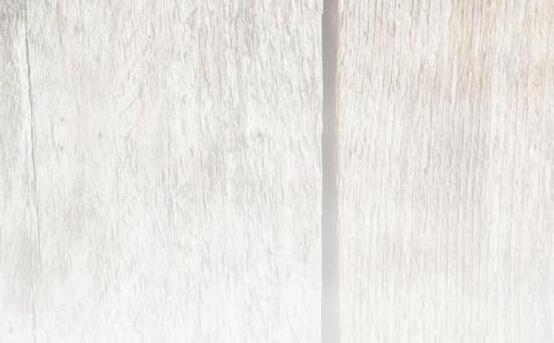
14 minute read
Guns have changed everything, especially childhood WRITERS ON THE RANGE
My gun education was furthered at a Catholic summer camp, and I still have my paper target proving my marksmanship. Hunter safety classes, and calm, clear-eyed common sense. is was the rural approach to guns I grew up with.



en it’s a story we all know: Guns became politicized. Polarized. Lobbyized. Humans are good at inventing things, so guns got more militarized as they turned into weapons of mass destruction. Our laws, sadly, didn’t keep up, because humans can also move quite slowly.
en, I had children, and suddenly, active-shooter drills were part of their curriculum. And then, on Valentine’s Day 2018, parents across Fort Collins, Colorado, received emails informing us that our children had been in a lockdown drill at roughly the same time that 17 children were being killed in Florida.

My brain fritzed out with confusion: Here a drill, but in Florida, children were being mowed down. Relief, and yet also great grief. Other mothers were getting di erent news.
My kids came home, stunned, and recounted their drill instructions, which included advice such as: “If you must ght to save your life, ght with all your might, using anything within reach as a weapon.”
Yes, kids, please ght with all your might against a grownup with a semiautomatic.
What a sad curriculum. What a sad country. Many of us know this. Many of us keep saying the same thing over and over, and a few loud voices keep pushing back. Why even discuss interpretations of the murkily written
Second Amendment to the U.S. Constitution, written at a time when muskets were the weapon of the day? Some conversations aren’t worth having.
What I am interested in is brainstorming real solutions — with like-minded people who also felt a real crack in their hearts every day that innocent people are mowed down, which, it seems, is nearly every day. A day without a shooting now seems the exception.

It strikes me that besides gun zealotry or idolatry, the other tragedy here is our seeming unwillingness to act. Really act. Act like grownups. My daughter and her friends helped organize a walkout to protest gun violence, which spread to other schools. Kids poured out of the high schools and toward the town center, and parents rode their bikes or walked alongside — especially near the coal-rolling trucks lled with counter-protesters that heckled them from the roads. is was the rst act of civil disobedience for most, borne out of a mix of desperation and courage.
Even as the kids gathered to pass the mic and speak, my heart was sunk even lower. Why? I knew what you know: Nothing would really change. Not until the adults of this country protested seriously, left work, took to the streets. e students protested, marched, wrote letters, made calls, and I watched, knowing. Adults wouldn’t go the distance. ere’s not enough will.
It’s ironic: I grew up with guns, but my salient memory of childhood was peaceful summer walks through a green eld, carrying a .22 to go practice shooting. Tragically, that is not true for youngsters today. ey might not shoot as much, but they’re the ones forced by our irresponsibility and inaction to have it forefront in their minds and hearts. e big thing we can do is ban assault weapons immediately, and, even more importantly, elect gun-sensible politicians who don’t take NRA money. maybe not. Are there people whose actions and words are driving us crazy? Absolutely. Do we sit stunned as we read or watch the news, wondering, “What idiot thought that was a good idea?” Or maybe we just let the anger and resentment fester inside of us until it reaches a boiling point or creates an ulcer. And then we share our outrage with anyone who will listen. And even if there is no one to listen, we go on a rant on social media, posting our anger and frustration, continuing to carrying the weight of what’s wrong with the world on our shoulders.
So, solutions. I celebrate Moms Demand Action, a group founded by a mother of ve right after the Sandy Hook tragedy, based on her belief that all Americans should do more to reduce gun violence. No group has “risen so far, so fast, in uencing laws, rattling major corporations, and provoking vicious responses from hardcore gun rights activists,” according to Mother Jones.
Although I’m all for background checks and safety locks, these seem like tiny bandages on a gaping wound.




If not Moms Demand Action, there is the Coalition to Stop Gun Violence and Gun Owners for Safety. All these groups need people willing to spend some time calling legislators, step up, protest. People like you. People who believe in common sense. People who believe in childhood.
Laura Pritchett is a contributor to Writers on the Range, writersontherange.org, an independent nonpro t dedicated to spurring lively conversation about the West. She is the author of several novels and non ction books and directs a program in nature writing at Western Colorado University.
A return to grace means that instead of playing the blame game, we play the love and forgiveness game. I know, I know, I have heard it before that this is not a realistic approach in dealing with the nonsense and idiotic decisions being made and the ridiculous actions of those who we do not agree with. And everyone is entitled to their own opinions.
My opinion and position are that I would rather live under the spirit of love and forgiveness as opposed to harboring anger, resentment, and frustration relative to the things that I have absolutely no control over. And if you still disagree with me, or think I am a bit too naïve, then maybe this can be your rst attempt at o ering me some grace.
Will society ever be perfect? No. Will people ever be without fault? No. Will the world ever get back to what the majority of us would call normal? Maybe, maybe not. But wouldn’t it be a better place if we all gured how to o er love and forgiveness instead of spite and hostility?




As always, I would love to hear your story at gotonorton@gmail.com, and when we can truly make that leap towards a return to grace, it really will be a better than good life.

Michael Norton is an author, a personal and professional coach, consultant, trainer, encourager and motivator of individuals and businesses, working with organizations and associations across multiple industries.

BY RYLEE DUNN RDUNN@COLORADOCOMMUNITYMEDIA.COM
Spring is in full swing, bringing many folks around Colorado out of the doldrums of winter with the promise of outdoor recreation.
For folks who aren’t fans of “traditional sports” — think baseball, basketball, football, soccer — there are plenty of unique, exciting alternatives throughout the Centennial State. From roller skating to parkour, there is no shortage of variety in Colorado’s recreation options.
Roller skating, roller hockey and roller derby
Roller sports are alive and well in Colorado. Folks have quite a few options for activities revolving around wheeled feet; from roller skating to roller hockey to roller derby, there is no shortage of options.
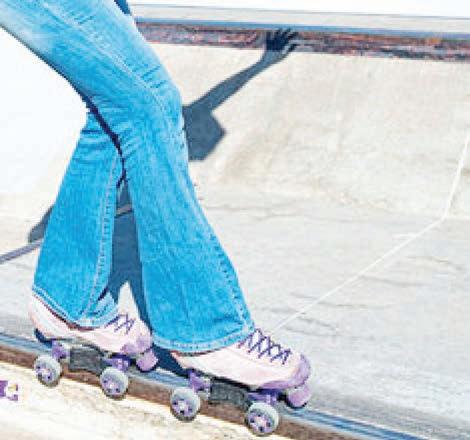

Roller skating lovers have a plethora of skate parks in the metro area and can get all of their gear — and some lessons — from the newlyopened Denver Skates Shop in Arvada. e store provides ttings and skating lessons for folks ranging from novices to experienced park skaters.
Brina Wyss, a sales associate and coach at Denver Skates Shop, said that roller sports experienced a surge in popularity during the COVID-19 pandemic that’s since died down, but has nonetheless roughly doubled the community’s size.
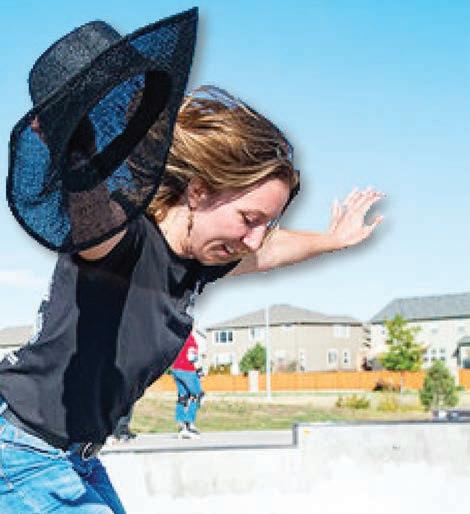
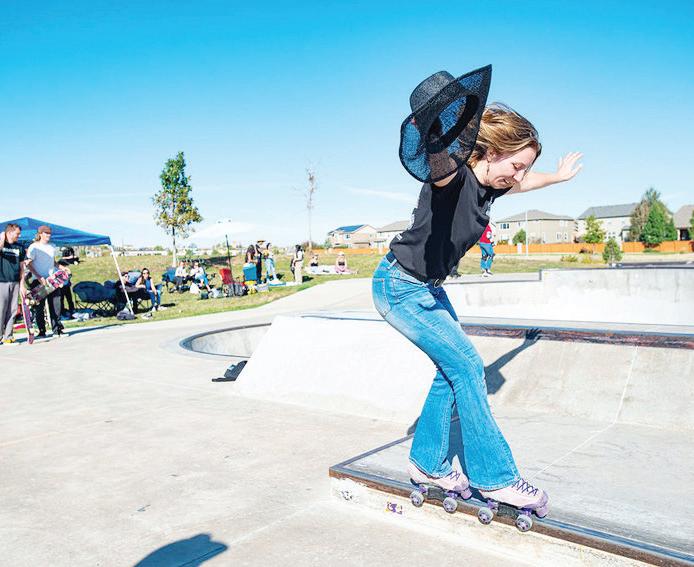
“I think there was a big surge in interest in wheels and skating during the pandemic, but it was a trend” Wyss said. “I people had a lot of spare time and were looking for something active to do. e community has de nitely grown at least twice as much during the pandemic.”
Wyss participates in roller derby, which is played at the professional and recreational level in Colorado. Wyss said the competitive nature and team atmosphere of roller derby came to be a replacement for volleyball, which she played competitively growing up.
“A lot of people do (skating) for joy and exercise,” Wyss said. “I do it as a way to escape, and it’s also a great way of community meeting.”
Denver Roller Derby operates a large number of recreational and traveling teams and has opportunities for new players.
Folks looking for a non-contact alternative to ice hockey might nd roller hockey appealing — Skate City operates rinks in Arvada, Westminster and Littleton that o er roller skating and hockey, while Rocky Mountain Roller Hockey operates youth and adult leagues out of the Foothills Fieldhouse in Lakewood, and the Parker Fieldhouse also hosts youth and adult roller hockey.
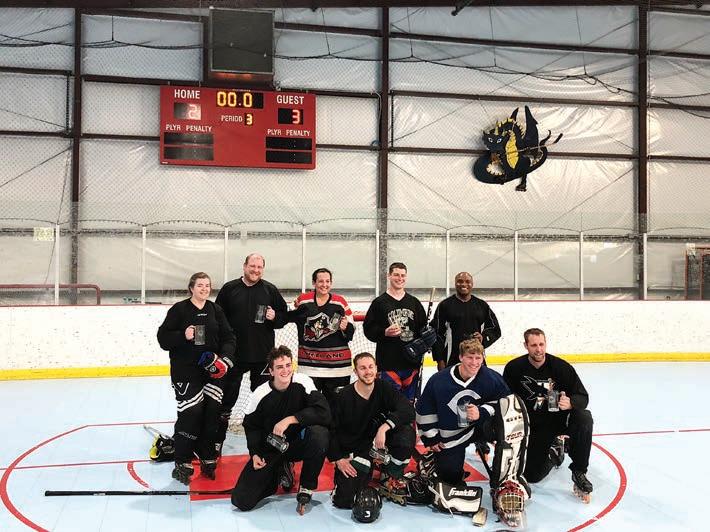
Ultimate frisbee/disc golf
Frisbee sports have come into favor in Colorado recently — a semiprofessional ultimate frisbee team kicked o their inaugural season in Golden this month — with two main ways to play.
Ultimate frisbee resembles American football in that teams must complete passes in an end zone to score points. As the name suggests, disc golf resembles “traditional” golf, but is played with a disk instead of a ball. e Denver Summer Ultimate League is the oldest ultimate frisbee competition in the state, and just nished registration for its 2023 season.

Disc golf fans may nd more frequent playing options. In Arvada, the Johnny Roberts Disc Golf
Course and Birds Nest Disc Golf Course both operate at city parks.
Colorado Christian University operates a disc golf course in Lakewood, and Foothills Parks and Recreation operates the Fehringer Ranch Disc Golf Course in Morrison.

For those looking for a more secluded experience, the Wondervu Disc Golf Course in Golden is considered to be one of the most scenic — and challenging — courses around.
Parkour
According to gym owner Lorin Ball, the de nition of parkour is simple: “Using environment to get from point A to point B in the most e cient way possible.”
Ball is the owner of Flow Vault, a parkour and ninja warrior — yes, American Ninja Warrior — training gym in ornton. Flow Vault opened in 2008 and o ers classes to people ages 5 and up. His gym has even graduated some ninja warriors to the popular NBC show.
“It’s a full curriculum, similar to that of gymnastics, where you have di erent levels of progressions,” Ball said. “We’re training people to be more intentional with their movement and apply that to other sports or physical activities that they do.”
Other parkour gyms in the area include APEX Denver, Path Movement in Littleton and Ninja Intensity in Parker.
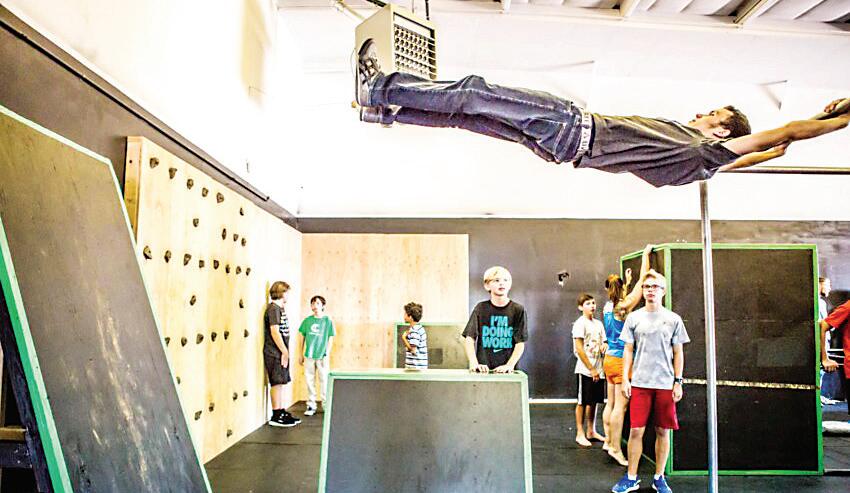
Aerial Adventures
Finally, Colorado has no shortage of arial adventure options. Ropes courses and adventure parks are plentiful in the Centennial State and are often and family-friendly way to recreate uniquely.
e Colorado Adventure Center is based in Idaho Springs, e EDGE Ziplines and Adventures is in Castle Rock, and the Treehouse Adventure Park is based in Bailey.
obstructs parental supervision” and “enables (drug) dealers to locate and access nearby minors and young adults,” per the news release.
Bergman said Snapchat provides people the opportunity to commit a crime knowing that the evidence is destroyed after the crime is committed, since Snapchat automatically deletes messages.
“ e disappearing message feature allows drug dealers to actually put a menu or a smorgasbord of drugs online, knowing that the evidence of their crime will … disappear,” Bergman said. “ e only bene t of the disappearing messages is to perpetrate crimes.”
Bergman noted Snapchat also has a geolocating feature, also called a “Snap map,” that allows users to share their location with one another. is feature allows for drugs to be delivered “like DoorDash or Uber Eats,” he said.
A third feature that Bergman said “unnecessarily facilitates young people hiding, forever, evidence of their solicitation of drug dealers” is Snapchat’s “my eyes only” feature, which allows for users to hide content behind a passcode on the app. “ ey have made (an) intentional decision to not change the architecture of their platform, presumably because one of the appeals of the platform is to encourage kids to evade parental responsibility,” he said about Snapchat. “ ey’ve decided to not implement readily available design modi cations because it reduces engagement, and their pro ts are tied to engagement.” e lawsuit’s prayer for relief, meaning the damages and other remedies it is seeking, includes requests for punitive damages, loss of future income and earning capacity of each of the nine people, and monetary and emotional damages su ered by plainti s.
“ is is not a case that is about the money. ese families have suffered the worst loss that anybody can imagine,” Bergman said. “If through these e orts, we can prevent one family from going through this loss … then it’s worth it.”
The relationship between fentanyl and social media
At least every other day, the Social Media Victims Law Center hears from another parent who lost a child to fentanyl, Bergman said.
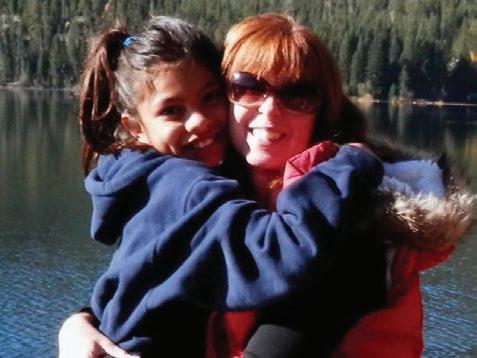
“I can’t tell you how horrible it is to get all of these calls,” he said. “We have 70 cases led involving children who have died of fentanyl.”
Bergman urges parents to have open discussions with their children about the risk of fentanyllaced drugs.
“It’s a hard discussion to have because no kid is ever gonna want to admit to their parent that they might be tempted to use Oxy or
Percocet or something like that,” he said. “But I think you need to have the kind of discussion and relationship with your kids so that they understand that they can die from this … and that the prospect of getting drugs online from a stranger is not worth the risk.” e Colorado Department of Public Health and Environment found that the state’s total number of drug overdose deaths due to synthetic opioids mentioning fentanyl increased from 540 deaths in 2020 to 912 deaths in 2021, representing an increase of nearly 69%. e report describes the challenges that social media platforms like Snapchat may present to law enforcement investigations, given the “disappearing content.”
“As opposed to just saying, ‘Don’t ever do this,’ saying, ‘If you — I hope you never do it, but if you do, don’t do it this way,’” he added.
According to the United States Drug Enforcement Administration (DEA), fentanyl is involved in more deaths of U.S. citizens under the age of 50 than any other cause of death.
As reported by Bloomberg in January, the Federal Bureau of Investigation is examining Snapchat’s role in fentanyl poisoning deaths.
Bergman said the Social Media Victims Law Center only has one case where Snapchat was not the conduit through which the fentanyl-contaminated drugs were obtained.
“ e fentanyl phenomenon appears to be a Snapchat-only problem, arising from the unique design of the Snapchat platform,” he said.
Colorado Attorney General Phil Weiser released a report in March highlighting how social media platforms are used for illicit drug activity.
In the report, it notes that online access to illicit drugs is a “whole-ofInternet” challenge, as drug sellers are often active on multiple social media platforms.
“When platforms intentionally tout features like near-immediate deletion of communication exchanges and short retention periods of data held on the platforms’ servers, it puts law enforcement at an extreme disadvantage when investigating those using the platforms for illegal activities like selling drugs,” said Cmdr. Nick Goldberger of the Boulder County Sheri ’s O ce in a news release. e report also mentions the Social Media Victims Law Center’s civil lawsuits against Snap Inc. “ is is, by any fair estimation, cutting-edge litigation. And it is unclear how this is all going to come out because we’re the rst rm to do it,” Bergman said. “We have no illusions that this is an easy ght. And we have every expectation that Snapchat is going to ght every step of the way.”
Snapchat’s response
In an emailed statement to Colorado Community Media, a Snap Inc. spokesperson wrote, “While we can’t comment speci cally on active litigation, we can share all the progress we have made in this area.
“We use cutting-edge technology to help us proactively nd and shut down drug dealers’ accounts. We block search results for drug-related terms, redirecting Snapchatters to resources from experts about the dangers of fentanyl.
“We continually expand our support for law enforcement investigations helping them bring dealers to justice, and we work closely with experts to share patterns of dealers’ activities across platforms to more quickly identify and stop illegal behavior.
“We will continue to do everything we can to tackle this epidemic, including by working with other tech companies, public health agencies, law enforcement, families and nonpro ts.” ere has also been a decline in community-reported content related to drug sales, per the statement. Snap Inc. said in September 2021, more than 23% of drug-related reports from Snapchat users contained content speci cally related to sales. As of December 2022, it was 3.3%.
According to the statement from Snap Inc., Snapchat has a new in-app parental tool, called Family Center, so parents can see all the friends their teens are communicating with on Snapchat and report any accounts for investigation.
In the statement, Snap Inc. said it preserves and discloses data in re- sponse to valid legal requests. e company published a statement in January on how it works with law enforcement authorities.


On May 9, which was National Fentanyl Awareness Day, the company said on its website that it has been working with senators on legislation, speci cally the Cooper Davis Act, that would create a legal framework for tech companies to share information about drugs with law enforcement.
Hoping for change
Bergman said the Social Media Victims Law Center’s purpose is to “address the carnage that social media has in icted on young people, not only in the United States but around the world.”
He pointed to the increased rates of mental health issues and suicide.
According to the Centers for Disease Control and Prevention (CDC), rates of depression and anxiety among young people have increased over time.
Suicide rates increased roughly 36% between 2000 and 2021, and suicide was the second leading cause of death for people ages 1014 and 20-34 in 2021, per the CDC. e National Alliance on Mental Illness said on its website that research has shown people who spend more time on social media and less time interacting with others have an increased risk of feeling anxious and depressed. It notes, however, that it is di cult to know if spending time online actually causes anxiety and depression.
One of the allegations in the lawsuit is that Snapchat is designed to be addictive to minors.
“Social media is not going to go away. It’s going to be part of our lives for generations, but it doesn’t have to be as dangerous as it is,” Bergman said. “What I hope is that the companies will change how they design their platforms, and that they’re safer.”
Patti Lujan hopes that with this lawsuit, Snapchat will change its ways, if not go away completely. She said the platform allows criminals to hide, and she wants it to change so that messages and posts do not disappear.
“I’m hoping that they change their platform completely so these things are not hidden, and that if something happens, at least we can nd the person responsible,” she said.
She wants parents to talk with their kids about what can happen on Snapchat.
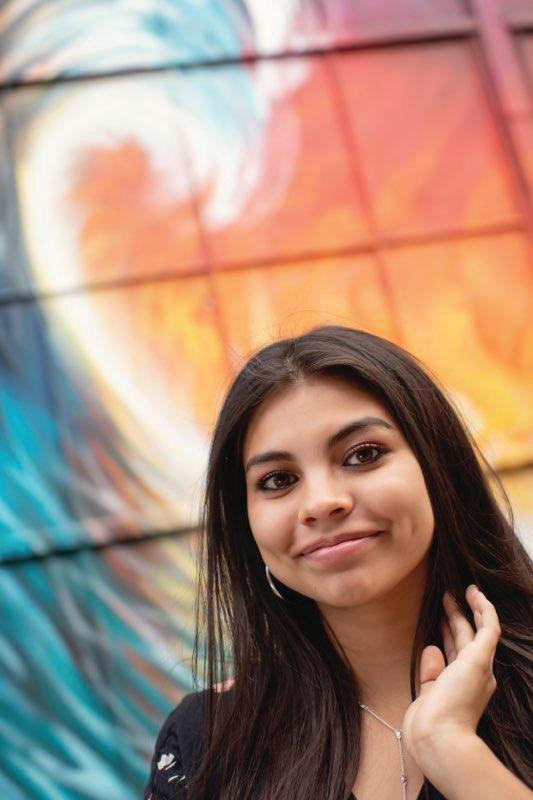
“I really want to make parents aware of what’s happening, because … I was just so naive to all of it,” she said. “It just never even entered my mind that this could be going on.”
Lujan hopes to educate people about the fentanyl crisis and the importance of not taking substances that came from unknown places.
“I’m just hoping some other parents … see this and maybe it can save someone else’s life,” she said. “It’s what Lauren would want me to do.”










